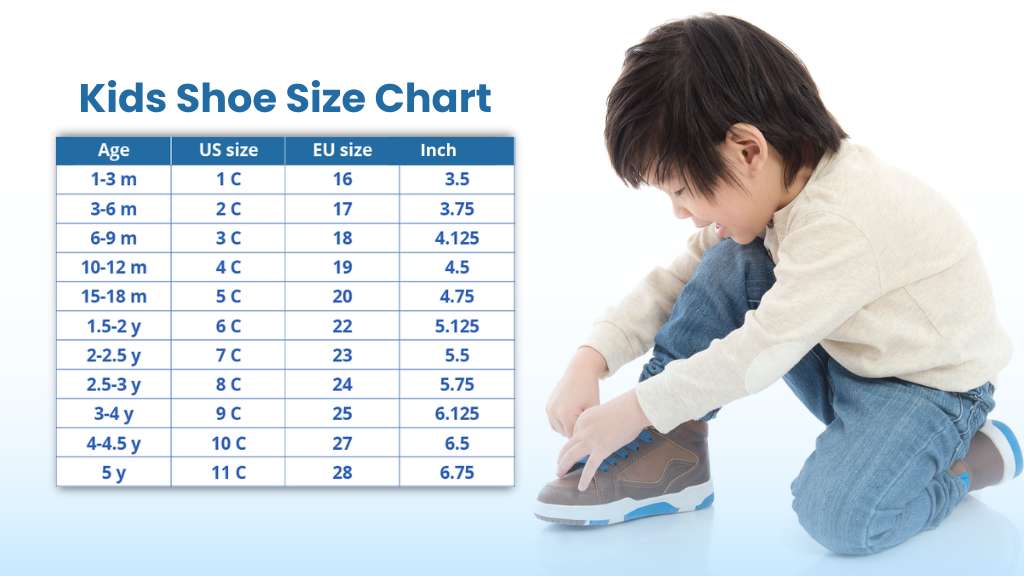
Kids’ shoe size charts are designed to accommodate the growth and development of children’s feet. The sizing system for kids’ shoes typically varies by country, but it generally follows a similar pattern. Here are some key points to know about kids’ shoe sizes:
1. Age
Age ranges often categorize age and size correlation Shoe sizes for children, although individual growth rates can vary. It is important to note that these age ranges are approximate and not all children will fit within them. Additionally, children’s feet can grow at different rates, so it’s essential to measure their feet for an accurate fit even before you refer to a kids’ shoe size chart.
2. Measurement Units
Kids’ shoe sizes are usually measured in various units, such as US, UK, European (EU), and centimeters (cm). Each unit of measurement corresponds to a specific shoe size. For example, in the United States, shoe sizes for kids typically range from 0 (newborn) to 13.5 (older child), with additional youth sizes starting from 1Y.
3. Foot Measurement
To determine the appropriate shoe size for a child, it’s recommended to measure their feet. You can use a measuring tape or a foot-measuring device available at many shoe stores. Measure the length and width of the child’s feet, as shoe width can also vary. Compare the measurements to a sizing chart specific to the unit of measurement you are using to find the corresponding shoe size.
4. Growth Room
It’s important to allow some room for growth when buying kids’ shoes. Typically, it is recommended to leave about a half-inch (1.3 cm) of space between the longest toe and the end of the shoe. This extra room accommodates natural foot growth and ensures comfort.
5. Trying On Shoes
Whenever possible, have the child try on the shoes before purchasing them or looking at a kids’ shoe size chart. Children’s feet can have different shapes, and shoe brands may vary in size, so it’s beneficial to check the fit and comfort of the shoes firsthand.
6. Specialty Shoes
Some children may require specialty shoes due to foot conditions or specific activities. In such cases, it is advisable to consult with a pediatrician, podiatrist, or footwear professional who can guide finding the appropriate shoes.
Remember that the information provided in our kids’ shoe size charts is general, and it’s always best to consult specific sizing charts or seek professional assistance to ensure an accurate fit for your child’s shoes.
Things To Remember About Kids’ Shoe Size Charts
Before referring to the sizing charts, it’s important to understand a few key points.
- Firstly, there are no gender-based distinctions in kids’ shoe sizes. Whether it’s for boys or girls, or even those adorned with princess motifs, the sizes remain the same.
- The sizes are categorized based on different age groups: small or little kids’ sizes for newborns, infants, and toddlers; big kids’ sizes, and youth sizes.
- Kids’ shoe sizes range from 0C for newborns to 10C for children around 4 years old. Youth sizes span from 1Y to 7Y.
- If your child requires sizes larger than 7Y, it’s time to transition to adult shoe sizes.
4 To 6 Years Old Kids’ Shoe Size Chart
In the United States, children’s shoe sizes for kids aged 4 to 6 range from 10C to 13.5C. If you’re shopping for international brands, it’s important to note that UK shoe sizes for children in this age group are typically half a size smaller.
For instance, a US size 11C shoe would correspond to a UK size 10.5. When it comes to European shoe sizes for children of these ages, you can either add 17 to the US size or refer to a sizing chart for more guidance. Find the kid shoe size chart right here:
| US | UK | EU | Foot Length | |
| Inches | Centimeters | |||
| 10 | 9.5 | 27 | 6 5/8″ | 16.6 |
| 10.5 | 10 | 27.5 | 6 3/4″ | 16.9 |
| 11 | 10.5 | 28 | 6 7/8″ | 17.3 |
| 11.5 | 11 | 28.5 | 7″ | 17.6 |
| 12 | 11.5 | 29 | 7 1/8″ | 17.9 |
| 12.5 | 12 | 30 | 7 1/4″ | 18.5 |
| 13 | 12.5 | 30.5 | 7 3/8″ | 18.8 |
| 13.5 | 13 | 31 | 7 1/2″ | 19.2 |
7 To 12 Years Old Kids’ Shoe Size Chart
Typically, there is a notable difference between shoe sizes for youth and adults. Youth sizes, labeled from 1Y to 6Y, are typically suitable for children between the ages of 7 and 12. You can refer to a youth size chart for shoes to find the appropriate size. Find US kids’ shoe size chart right here:
| US | UK | EU | Foot Length | |
| Inches | Centimeters | |||
| 1 | 13.5 | 31.5 | 7 5/8″ | 19.5 |
| 1.5 | 1 | 32.5 | 7 7/8″ | 20.0 |
| 2 | 1.5 | 33 | 8″ | 20.4 cm |
| 2.5 | 2 | 34 | 8 1/4″ | 21.0 |
| 3 | 2.5 | 34.5 | 8 3/8″ | 21.3 |
| 3.5 | 3 | 35 | 8 1/2″ | 21.7 |
| 4 | 3.5 | 35.5 | 8 5/8″ | 22.0 |
| 4.5 | 4 | 36.5 | 8 7/8″ | 22.6 cm |
| 5 | 4.5 | 37 | 9″ | 23.0 |
| 5.5 | 5 | 38 | 9 1/4″ | 23.6 |
| 6 | 5.5 | 39 | 9 3/4″ | 24.7 |
What Is The Recommended Amount Of Space For Children's Shoes?
If there is less than a half-inch (12 mm) of room between the toes and the front of the shoe, it’s necessary to purchase new shoes. Conversely, when getting new shoes, it’s advised to leave a minimum of three-quarters of an inch (17 mm) of free space to allow the feet to move comfortably.
Children’s feet can experience rapid growth, with the potential to grow up to an inch per year (equivalent to two shoe sizes!). It is crucial to invest sufficient time when purchasing shoes for your child, as ill-fitting footwear can lead to permanent harm. Make sure to regularly measure their feet and consult our kids’ shoe size chart for accurate comparisons. If uncertain or in between sizes, it is advisable to choose the larger size.
How Do You Navigate A Kids’ Shoe Size Chart?
To find your way through a kid shoe size chart, follow these steps:
- Flatten the foot and place it on a piece of paper, ensuring the sole is down.
- Trace the foot’s outline by holding the pencil upright and keeping the toes together.
- Next, measure the foot’s length using a ruler, and refer to our shoe size chart to find the corresponding size.
An Endnote On Kids’ Shoe Size Charts
One fun fact about kids’ shoe size charts is that they often include creative and playful illustrations or designs to engage children and make the process more enjoyable. Many shoe companies and brands recognize that children may find trying on shoes or getting measured a bit tedious, so they incorporate fun elements into their size charts.
These can include colorful graphics, cartoon characters, or interactive features that make the experience more entertaining for kids. These creative touches aim to turn a practical task into a playful and enjoyable moment for both children and parents.
FAQs: Kids’ Shoe Size Chart
1. What size shoes are kids?
2. Are size 13 and size 1 the same?
3. What size shoe is a 3-year-old?
4. How do I know my kids' shoe size?
On behalf of the editorial team at Parenthoodbliss, we follow strict reporting guidelines and only use credible sources, along with peer-reviewed studies, academic research institutions, and highly respected health organizations. To learn about how we maintain content accurate and up-to-date by reading our medical review and editorial policy.










